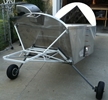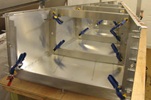


random user submitted photo
Gases passing through pulled rivets
14 posts
• Page 1 of 2 • 1, 2
Gases passing through pulled rivets
I am interested in filling the firewall rivets to prevent engine gasses from entering the cockpit. Does anyone have an idea on what to use for this purpose?
Onex 150
- inventor
- Posts: 71
- Joined: Tue Jun 09, 2015 8:35 am
- Location: Oregon
Re: Gases passing through pulled rivets
This stuff is very good for the purpose. https://www.aircraftspruce.com/catalog/ ... 0caulk.php
David Clifford
Howell & Gladwin, MI
RV-9A: Under Construction (I'm a repeat offender!)
RV-10: Built & Sold: Flying Since 2013 N959RV
Cozy MKIV: Built & Sold: Flying Since 2007 N656TE
Howell & Gladwin, MI
RV-9A: Under Construction (I'm a repeat offender!)
RV-10: Built & Sold: Flying Since 2013 N959RV
Cozy MKIV: Built & Sold: Flying Since 2007 N656TE
-

9GT - Posts: 58
- Joined: Tue Apr 05, 2016 4:23 pm
- Location: Howell, MI
Re: Gases passing through pulled rivets
Is a little dot of red rtv acceptable?
Waiex 158 New York. N88YX registered.
3.0 Liter Corvair built, run, and installed.
Garmin panel, Shorai LiFePo batteries.
3.0 Liter Corvair built, run, and installed.
Garmin panel, Shorai LiFePo batteries.
- GordonTurner
- Posts: 669
- Joined: Tue Feb 21, 2012 1:14 am
- Location: NY, NY
Re: Gases passing through pulled rivets
You might get some tips here.
https://www.eaa.org/Videos/Hints-for-Homebuilders/Firewall-Forward/2664972455001
Wes
https://www.eaa.org/Videos/Hints-for-Homebuilders/Firewall-Forward/2664972455001
Wes
Wes Ragle
Onex #89
Conventional Gear
Long Tips
Hummel 2400 w/Zenith Carb
Prince P Tip 54x50
First Flight 06/23/2020
42.8 Hrs. as of 10/30/21
Onex #89
Conventional Gear
Long Tips
Hummel 2400 w/Zenith Carb
Prince P Tip 54x50
First Flight 06/23/2020
42.8 Hrs. as of 10/30/21
- WesRagle
- Posts: 900
- Joined: Fri Jan 05, 2018 12:35 pm
- Location: Weatherford, Tx
Re: Gases passing through pulled rivets
That is a good video. I am thinking of using JB weld on the rivet holes for a more permanent seal. I am thinking that I could still drill out the rivet if I had to.
Onex 150
- inventor
- Posts: 71
- Joined: Tue Jun 09, 2015 8:35 am
- Location: Oregon
Re: Gases passing through pulled rivets
hi all,
yes the eaa video shows using Dap alex ultra 230 caulk. i used white on bottom rivets on plane,
clear on firewall. bought a co detector online from walmart $30.
fly safe,
michael
yes the eaa video shows using Dap alex ultra 230 caulk. i used white on bottom rivets on plane,
clear on firewall. bought a co detector online from walmart $30.
fly safe,
michael
- WaiexN143NM
- Posts: 1206
- Joined: Mon Sep 15, 2014 1:04 am
- Location: palm springs CA
Re: Gases passing through pulled rivets
I also bought one of those small CO detectors at Walmart. I am hoping to use a co detector connected to my onboard computer eventually but have the portable unit if I don't get er done in time to fly. I know someone who was killed by CO in the cabin of an airplane, so nothing to play around with in a small cockpit. Thanks for the reply.
Onex 150
- inventor
- Posts: 71
- Joined: Tue Jun 09, 2015 8:35 am
- Location: Oregon
Re: Gases passing through pulled rivets
hi all,
yes good to have a co detector. the cheapest one from acs was about $150. many deaths attributed to co fumes. leaky or cracked exhaust . The most high profile one lately was soccer star sala. Remember the PA-46 Malibu that crashed into the english channel at nite about 6 mo ago? Forget that the pilot was not ifr rated , but was flying at nite ifr over the english channel on a stormy nite. Sala’ s body recovered inside the plane. lethal,levels of CO. the pilots body was outside of the cabin somewhere, will never be found. Surmised that CO killed the pilot and the plane crashed.
be safe......
WaiexN143NM
Michael
yes good to have a co detector. the cheapest one from acs was about $150. many deaths attributed to co fumes. leaky or cracked exhaust . The most high profile one lately was soccer star sala. Remember the PA-46 Malibu that crashed into the english channel at nite about 6 mo ago? Forget that the pilot was not ifr rated , but was flying at nite ifr over the english channel on a stormy nite. Sala’ s body recovered inside the plane. lethal,levels of CO. the pilots body was outside of the cabin somewhere, will never be found. Surmised that CO killed the pilot and the plane crashed.
be safe......
WaiexN143NM
Michael
- WaiexN143NM
- Posts: 1206
- Joined: Mon Sep 15, 2014 1:04 am
- Location: palm springs CA
Re: Gases passing through pulled rivets
inventor wrote:I also bought one of those small CO detectors at Walmart. I am hoping to use a co detector connected to my onboard computer eventually but have the portable unit if I don't get er done in time to fly. I know someone who was killed by CO in the cabin of an airplane, so nothing to play around with in a small cockpit. Thanks for the reply.
On our return from Airventure, we had a CO situation that I'm really glad Gary had an active CO monitoring system. Our exhaust pipe had separated from the muffler. We mistakenly thought it wouldn't be an issue. But 10 Minutes into the next leg showed we were approaching dangerous levels. We returned to the last stop and fixed the muffler issue. Those CO cards with that blister tablet that turns black can tell you may be dying are fine, but they don't tell you the level. By the end of our return, I was actually feeling some effects of it, headache, etc, 10 minutes in. The SuperBee will have a similar system Gary had. Mobile, tells you the CO level, and around $150 from Amazon. Used by HVAC guys. Sealing rivets is fine. But the real issue is the vacuum of the cockpit from the outside. It literally sucks in all the air coming out of the cowl. The 10 minutes we had the issue, I held the CO monitor in various positions in the cockpit and adjusted various vents. Near the feet, much higher, near our faces, lower. The more we closed the cockpit, the higher the CO. Flip the vents to blast air in, the CO would drop. But not enough.
John Gillis
SEL Private, Comm Glider, Tow pilot (Pawnee Driver)
Waiex N116YX, Jabiru 3300, Tail dragger,
First flight, 3/16/2013. 403 hours and climbing.
Home: CO15. KOSH x 5
Flying a B-Model Conversion (Super Bee Baby!)
-

fastj22 - Posts: 1594
- Joined: Sun Aug 21, 2011 5:56 pm
- Location: Mile High
Re: Gases passing through pulled rivets
Found primary point for CO gases to enter my Sonex TD, was the small holes in the very end of the tail, one on underside for access to bolt holding the titanium, spring rod in place, and one in the vertical surface of tail spar. Have a Guardian CO detector, and when those holes where plugged, levels stayed very low.
David A.
David A.
- DCASonex
- Posts: 935
- Joined: Mon Sep 12, 2011 8:04 pm
- Location: Western NY USA
14 posts
• Page 1 of 2 • 1, 2
Who is online
Users browsing this forum: No registered users and 16 guests







